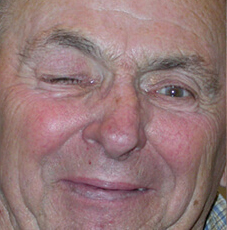 |
| Thirty days after botulinum toxin therapy, study patients with blepharospasm or hemifacial spasm demonstrated reduced rates of all blinking metrics. Photo: Sita Bhateja Specialty Hospital. Click image to enlarge. |
A recent study investigated whether blinking parameters return to normal in patients with blepharospasm or hemifacial spasm after treatment with botulinum toxin injections. The team found that while the treatment resulted in close-to-normal blinking frequency in affected patients, blinking amplitude and velocity were significantly lower in blepharospasm and on the affected side of hemifacial spasm compared with normal controls.
The study included 37 patients with blepharospasm (n=11) and hemifacial spasm (n=26) who were evaluated 30 days before and after Botox treatment, as well as 12 age-matched controls. Blinking was assessed in both patients and controls using a high-speed camera and microlight-emitting diodes. Study outcomes included blinking frequency, amplitude and maximum velocity of eyelid closure.
Compared with baseline, all blinking parameters were significantly reduced after Botox injections by the following percentages in blepharospasm and on the affected side of hemifacial spasm, respectively: 22% and 20% in amplitude, 21% and 39% in frequency and 41% and 26% in maximum closing velocity.
When compared with controls, the data revealed that blinking amplitude and velocity were significantly lower at 30 days in blepharospasm and on the affected side of hemifacial spasm. Even before Botox therapy, patients with either condition had a significantly lower velocity of eyelid closure compared with controls. The researchers explained in their paper, published in the Journal of Neuro-Ophthalmology, that this finding corroborates that from a recent study which observed “an increase in the percentage of slow fibers in orbicularis oculi muscle in hemifacial spasm patients, perhaps secondary to repeated involuntary contractions over years.”
The researchers concluded that the results of the present study show that blinking parameters in blepharospasm and hemifacial spasm patients do not become comparable to normal after Botox treatment. “These findings are in accordance with the slower and incomplete blinks clinically observed” at the slit lamp after Botox treatment, they wrote in their paper.
Gameiro GR, Osaki MH, Yabumoto C, et al. Blinking parameters do not normalize after botulinum toxin therapy in blepharospasm and hemifacial spasm patients. J Neuroophthalmol. June 12, 2023. [Epub ahead of print]. |

